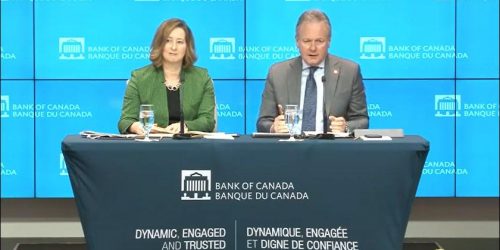Release of the Financial System Review
Good morning, and thank you for being here today. Senior Deputy Governor Wilkins and I are pleased to be with you to talk about the latest issue of the Bank of Canada’s Financial System Review (FSR), which we published today.
Let me quickly remind everyone about the purpose of the FSR—to identify key vulnerabilities in the financial system that can interact with and magnify economic shocks. We monitor the evolution of these vulnerabilities and apply extreme risk scenarios to look at the potential implications for the financial system and the economy should such a shock occur.
The main vulnerabilities that we see today are the same as those in the 2018 FSR—elevated levels of household debt and imbalances in housing markets. Both vulnerabilities have declined modestly over the past year.
With respect to household indebtedness, the mortgage stress tests introduced last year have improved the quality of new mortgage lending. As a result, the share of new mortgages going to highly indebted households—those that owe more than 450 per cent of their income—has declined significantly. Also, the number of Canadians falling behind on their debt payments remains low. The combination of the revised mortgage guidelines and past increases in interest rates have helped to slow the pace of household borrowing and stabilize the overall household debt-to-income ratio in Canada.
These are encouraging signs, but there are important reasons for continued vigilance. First, because the total amount of debt carried by Canadian households is so large, we know that it will be with us for a long time. Second, a large share of this debt is with highly indebted households. And third, the decline in global bond yields since the beginning of the year has lowered Canadian mortgage rates, so household borrowing is likely to pick up again. The Bank is also closely monitoring the risk that stricter mortgage guidelines are shifting consumers away from federally regulated institutions and toward private lenders and credit unions, some of which are not following the federal guidelines.
Let me now turn to imbalances in the housing market, which have diminished overall since our last report. We continue to follow three different housing stories here in Canada—the previously frothy markets in Toronto and Vancouver, the markets that are still adjusting to lower oil prices in Alberta and Saskatchewan, and the markets that are functioning normally almost everywhere else. After slowing sharply beginning in 2017, the Toronto area market appears to be stabilizing, while resales and prices continue to fall in the Vancouver area. Prices in both areas remain 40 to 60 per cent higher than they were four years ago, suggesting that housing imbalances remain an important macrofinancial vulnerability. The housing market as a whole continues to benefit from solid fundamentals, including population growth and strong job creation.
One more main vulnerability from the last FSR that we continue to watch is the possibility of a major cyber attack on a financial institution or market infrastructure, such as the payment systems that we all rely on every day. Cyber threats remain a key structural vulnerability, and the number of incidents that have or could have resulted in substantial financial losses has increased steadily over the past decade. Financial system participants are particularly concerned about cyber incidents at third-party service providers. The Bank has been working with major banks and financial market infrastructures to improve coordination and information sharing, which is crucial for improving resilience.
In this FSR, we have placed more focus on two other vulnerabilities. One relates to corporate debt funding. The level of non-financial corporate debt in Canada is well above its historical average. While the average firm has enough liquid assets to manage an increase in interest rates or a decline in income, some companies have relatively few liquid assets and less capacity to service their debts. In this context, lower-rated firms are relying more on US high-yield bonds and leveraged loans, and borrowers in these markets are more vulnerable to sudden swings in investor sentiment. We will be monitoring the situation.
We are also putting more emphasis on the vulnerability related to crypto assets. These continue to pose little threat to the financial system. But crypto markets and the uses of the underlying technology are changing quickly. So, implications for financial stability might arise suddenly. I would add that recent swings in prices for crypto assets and losses at crypto companies underline the need for investors to understand all the risks before they enter these markets.
We have also added a new vulnerability: climate change. There is a broad range of authorities that are tasked with assessing and mitigating the impacts of climate change. For central banks, the focus is on the risks that climate change poses to both the economy and the financial system. These include physical risks from disruptive weather events and transition risks from adapting to a lower-carbon global economy. The Bank is incorporating this risk into its analysis of the Canadian economy and financial system. We are also working to improve our understanding of climate risks as they relate to our mandate.
Turning from vulnerabilities to risks, I will conclude by saying the overall risk to the Canadian financial system has increased slightly since our last assessment nearly a year ago. This is due to the recent slowdown in economic growth in Canada and abroad. However, as we said in our recent Monetary Policy Report, we expect economic growth to pick up later this year. As for the risk of a severe house price correction, we judge that to be moderate and declining, with froth having decreased in the Toronto and Vancouver areas. Meanwhile, the risk of a sharp increase in long-term interest rates driven by higher global risk premiums is moderate, but increasing.
With that, Senior Deputy Governor Wilkins and I would be happy to answer your questions.


